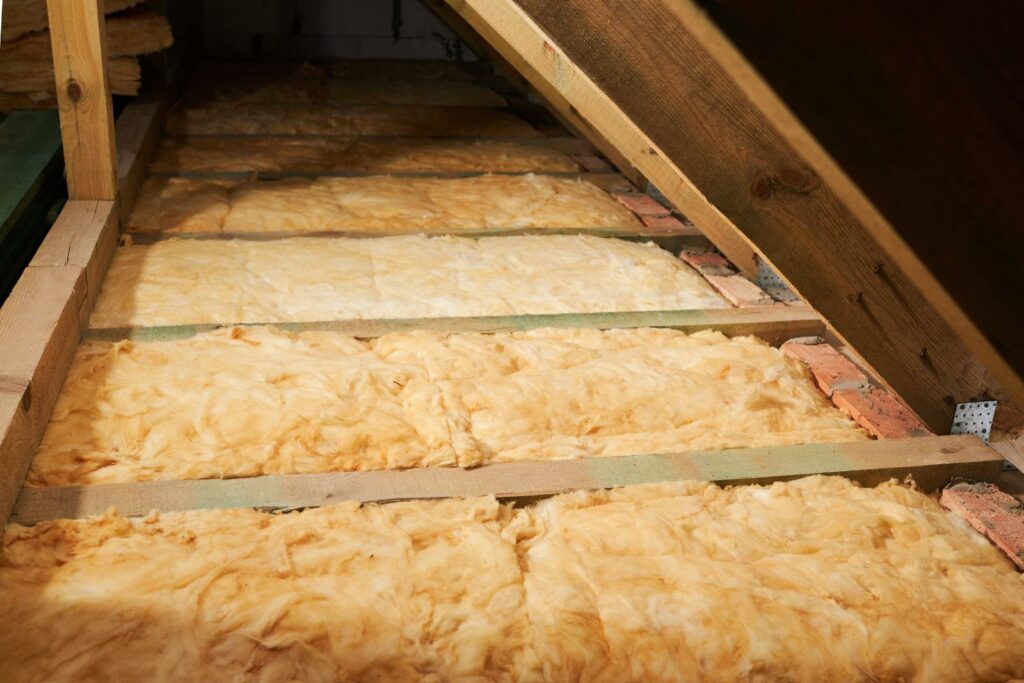
Contents
You might not be aware that blown-in attic insulation offers more than just thermal benefits. Have you ever considered how this type of insulation could help create a quieter living space for you and your family? By understanding the three key ways blown-in attic insulation reduces noise, you can take steps towards a more peaceful and serene home environment.
Key Takeaways
- Blown-in insulation absorbs sound vibrations effectively.
- It minimizes airborne noise transfer within the home.
- Reduces impact noise transmission like footsteps or furniture movement.
- Enhances soundproofing benefits for a quieter indoor environment.
- Fills gaps to act as a barrier against unwanted noise propagation.
Sound Absorption Properties
Blown-in attic insulation effectively absorbs sound due to its dense composition and ability to dampen noise vibrations. This insulation type provides excellent soundproofing benefits by reducing the transmission of unwanted noise within your home.
The acoustic insulation properties of blown-in attic insulation help in creating a quieter and more comfortable indoor environment by absorbing sound waves that try to pass through walls and ceilings.
When sound waves hit the dense material of blown-in attic insulation, they lose energy and are less likely to pass through, decreasing the amount of noise that enters your living spaces. The insulation’s ability to dampen noise vibrations is important in preventing sounds from traveling from one room to another, enhancing privacy and reducing disturbances.
By installing blown-in attic insulation, you can enjoy a more peaceful home environment, free from the interruptions of outside noises or activities within the house.
The acoustic insulation properties of blown-in attic insulation make it an excellent choice for homeowners looking to improve their living conditions by reducing noise pollution.
Whether you’re trying to create a serene atmosphere for relaxation or seeking a productive environment for work or study, this type of insulation can greatly contribute to minimizing unwanted sounds and enhancing your overall quality of life.
Minimizing Airborne Noise Transfer
To maximize noise reduction, it’s essential to enhance the insulation’s noise barrier properties alongside blown-in attic insulation. Blown-in insulation provides soundproofing benefits by reducing the transmission of airborne noises between rooms and floors. However, for the best noise reduction results, it’s crucial to improve the insulation’s noise barrier properties.
One way to enhance the soundproofing benefits of blown-in attic insulation is by installing acoustic panels or soundproof drywall. These materials can further absorb and block airborne noises, creating a more peaceful indoor environment. Additionally, sealing any gaps or cracks in walls, ceilings, and floors can prevent noise leaks and improve the overall effectiveness of the insulation.
Another effective method is to use soundproof curtains or rugs in conjunction with blown-in insulation. These textiles can help dampen sound waves and minimize airborne noise transfer, especially in areas where traditional insulation may not reach. Additionally, incorporating mass-loaded vinyl barriers or acoustic sealants can further enhance the noise barrier properties of the insulation, ensuring a quieter living space.
Impact Noise Reduction
Improving impact noise reduction in conjunction with blown-in attic insulation is essential for minimizing sound transmission through floors and ceilings. When considering the soundproofing benefits of insulation material, focusing on reducing impact noise is vital. Impact noises, such as footsteps, dropping objects, or moving furniture, can be a significant source of disturbance within a home.
Here are three key ways blown-in attic insulation aids in impact noise reduction:
Dampening Vibrations: Blown-in insulation materials like cellulose or fiberglass help dampen the vibrations caused by impact noises. When these materials are densely packed between floor joists, they absorb the energy generated by footsteps or other impacts, reducing the transmission of sound waves through the structure.
Increasing Mass: The added mass of blown-in insulation contributes to reducing impact noise. The heavier the materials used for insulation, the more effective they’re at blocking the transmission of impact noises between floors.
Filling Gaps and Cavities: Blown-in insulation can effectively fill gaps and cavities between floorboards and ceiling joists. By eliminating these spaces where sound waves can travel freely, the insulation material acts as a barrier against impact noise propagation.
Review
You now understand the significant impact blown-in attic insulation has on reducing noise in your home.
However, there’s one essential aspect you may have overlooked. Consider how a quieter environment can improve your overall well-being and productivity.
The benefits of reduced noise go beyond mere comfort; they can enhance your quality of life in ways you may not have realized.
So, take the necessary steps to create a peaceful sanctuary within your home.
Recent Posts
Top Attic Air Sealing Techniques for Insulation
Have you ever considered how much energy might be wasted through unnoticed gaps in your
Top 10 Attic Air Sealing Techniques for Insulation
Just as a tightly sealed ship avoids leaks and remains buoyant, your attic’s air sealing
What Are the Best Attic Air Sealing Techniques?
When it comes to attic air sealing, understanding the common leakage points is vital for

